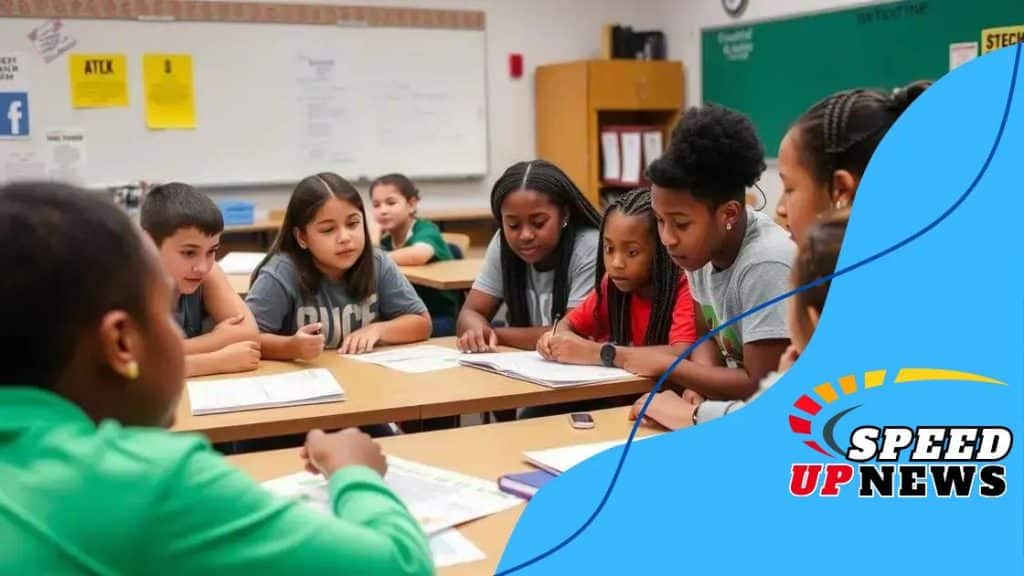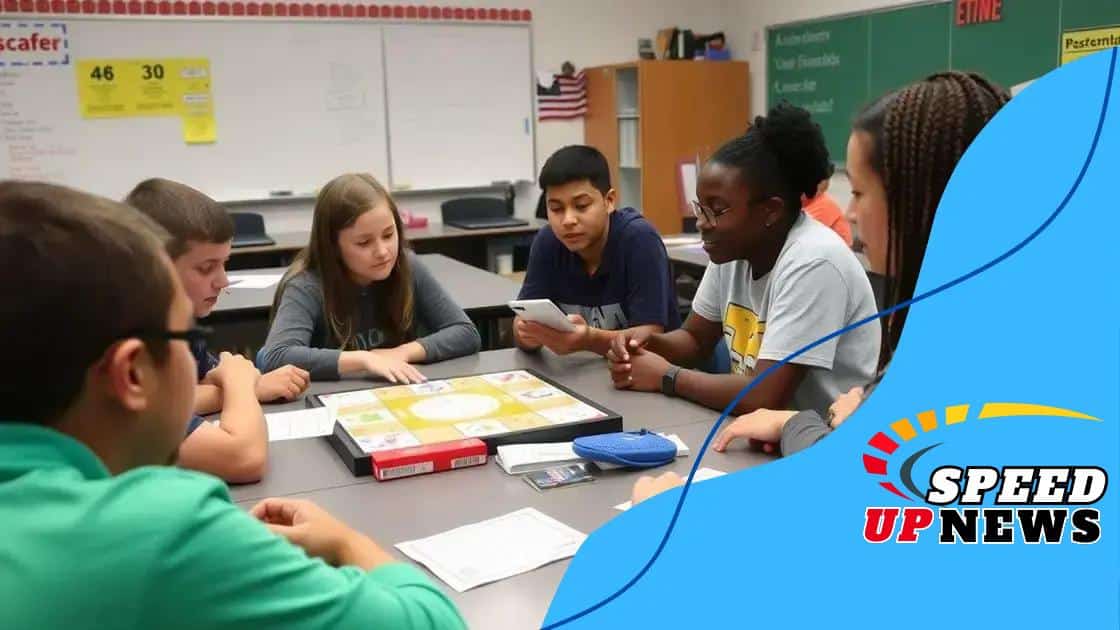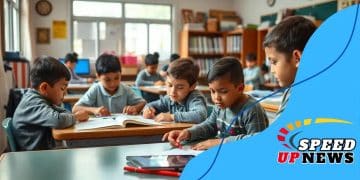Financial literacy programs for middle school students

Financial literacy programs for middle school students teach essential money management skills, helping them make informed financial decisions and prepare for future financial independence.
Financial literacy programs for middle school students are essential for equipping young learners with money management skills that last a lifetime. Have you thought about how these skills impact their future?
Understanding financial literacy
Understanding financial literacy is crucial for young students. It lays the foundation for healthy money management habits that can last a lifetime. Students in middle school are at a perfect age to start learning about how to handle money effectively. This knowledge will empower them as they grow and face real-life financial decisions.
What is Financial Literacy?
Financial literacy refers to the ability to understand and use various financial skills effectively. This includes budgeting, saving, investing, and making informed financial choices. Students will learn to make smart spending decisions, manage their allowances, and understand the significance of saving for future goals.
Key Components of Financial Literacy
- Understanding money management principles
- Recognizing the importance of savings
- Learning about the basics of investing
- Gaining knowledge about credit and debt
By grasping these core principles, students can make choices that improve their financial futures. For instance, learning how to create a budget helps them plan their expenses and avoid overspending. Simple exercises like tracking daily expenses can reinforce these lessons.
Furthermore, engaging with financial literacy programs can foster discussions about money in a fun and interactive way. For example, students can take part in games or simulations that illustrate real-world financial scenarios. These activities promote practical understanding and make learning enjoyable.
Overall, building a solid foundation in financial literacy at this early age is essential. It equips students with tools to manage their finances as they grow into young adults. By encouraging curiosity about money and its management, educators can help students become more confident with their finances in the future.
The importance of financial education in middle school
The importance of financial education in middle school cannot be overstated. At this crucial stage, students begin to form their understanding of money and its role in everyday life. Introducing financial concepts early prepares them for future financial independence.
Building a Strong Foundation
By incorporating financial education into the middle school curriculum, educators provide students with essential tools for success. Understanding concepts such as budgeting, saving, and investing can greatly influence their decisions as they navigate adolescence.
Benefits of Financial Education
- Enhances critical thinking skills related to financial decisions
- Improves their understanding of consumer rights and responsibilities
- Encourages positive saving habits that can last a lifetime
- Prepares students for financial challenges they may face later
As students learn about the differences between needs and wants, they become more disciplined in their spending habits. Financial literacy helps them realize the importance of setting goals, whether saving for a new game or planning for higher education.
Moreover, financial education creates an environment where students can discuss financial topics openly. This fosters a culture of awareness and responsibility. Engaging activities like role-playing or simulations allow them to practice these concepts in safe settings.
Developing a sense of financial awareness during middle school equips students with the confidence to manage their money effectively. This education helps in building a brighter financial future, paving the way for informed adults who can contribute positively to society.
Hands-on activities for teaching finance

Hands-on activities for teaching finance are essential in making important financial concepts relatable and engaging for middle school students. Using interactive methods helps them grasp complex ideas in a fun and memorable way.
Practical Financial Simulations
One effective approach is using simulations that mimic real-life financial scenarios. For instance, setting up a mock market where students can buy and sell goods with play money can teach them valuable lessons about supply, demand, and pricing. This type of activity not only enhances learning but also encourages teamwork and strategic thinking.
Budgeting Exercises
- Creating personal budgets based on fictional incomes
- Tracking expenses over a month using personal finance apps
- Participating in group projects to plan an event or trip within a budget
- Engaging in role-playing where students take on different financial roles
Through these budgeting exercises, students learn the importance of planning and prioritizing their spending. They can better understand the concepts of saving, investing, and making informed choices about their resources.
Incorporating games into finance education can also make learning enjoyable. For example, board games like Monopoly introduce students to property management and the impact of financial decisions in a competitive setting. These interactive experiences help reinforce key lessons in a playful manner.
Lastly, inviting community members to share their financial journeys can add personal relevance to the topic. Guest speakers can share experiences, tips, and insights that resonate with students, providing them with real-world examples of financial literacy in action.
Community programs promoting financial literacy
Community programs promoting financial literacy play a vital role in enhancing the financial knowledge of middle school students. These initiatives often focus on providing resources and engaging activities that help young people understand the importance of managing their money effectively.
Collaborations with Local Organizations
Many successful programs partner with local organizations, such as banks or non-profits, to offer workshops and seminars. These partnerships provide valuable insights into the financial world while allowing students to interact with professionals in the field. For instance, local banks might host sessions where students learn about saving, loans, and the importance of credit.
After-School Workshops
- Hands-on budgeting sessions where students plan a mock event
- Investing games that simulate real market conditions
- Workshops on consumer rights and avoiding scams
- Discussions led by financial experts to answer student questions
After-school programs focused on financial literacy can be very engaging. These activities often incorporate fun elements like games and role-plays, making it easier for students to digest crucial information about money management.
Another effective approach is community competitions where students create unique financial plans or business ideas. These challenges can build teamwork, boost critical thinking, and make learning about finance a competitive and enjoyable experience.
Ultimately, community programs serve as a bridge between theoretical financial education in the classroom and practical financial skills needed in daily life. As students engage in these programs, they gain confidence in their ability to manage finances and make informed financial decisions.
Measuring the impact of financial literacy initiatives
Measuring the impact of financial literacy initiatives is vital to understanding their effectiveness in improving students’ financial skills. By evaluating these programs, educators can determine what strategies work best and how they can be improved over time.
Assessing Student Knowledge
One common method to measure impact is through pre- and post-tests. These tests track the knowledge students gain from participating in financial literacy initiatives. This data helps identify areas where students excel and where they may still struggle. Teachers can adjust their lessons based on these insights to better address student needs.
Tracking Behavioral Changes
- Observing changes in spending habits among students
- Measuring the increase in savings rates
- Monitoring participation in financial programs outside of school
- Gathering feedback from students on their financial confidence
Behavioral changes provide a broader view of a program’s impact. For instance, if students start saving a portion of their allowance or make informed choices on purchases, these actions indicate that the initiative is having a positive effect.
Additionally, schools can collect feedback from students and parents about the programs. Surveys can reveal how students apply what they’ve learned in their everyday lives. This information is crucial for shaping future financial education efforts.
Engaging in long-term studies also helps track the effects of financial literacy over time. Researchers can analyze whether students retain the knowledge they’ve gained and continue to apply it as they transition into adulthood. This longitudinal data is essential for demonstrating the lasting benefits of financial literacy education.
In summary, financial literacy programs are essential for middle school students. They provide valuable education that helps shape students into informed individuals capable of making smart financial decisions. By participating in hands-on activities, engaging with community programs, and measuring the impact of these initiatives, students can gain confidence in their financial abilities. As they learn to budget, save, and make informed choices, they set themselves up for a successful future. The investment in their financial education today will pay off as they navigate the complexities of adulthood.
FAQ – Frequently Asked Questions about Financial Literacy Programs
What are financial literacy programs?
Financial literacy programs are educational initiatives designed to teach individuals about managing money, budgeting, saving, and investing.
Why are these programs important for middle school students?
They equip students with essential skills needed to make informed financial decisions as they grow into adulthood.
How can hands-on activities enhance learning?
Hands-on activities, like simulations and budgeting exercises, engage students and help them apply financial concepts in real-life scenarios.
How do we measure the effectiveness of these initiatives?
Effectiveness is measured through pre- and post-tests, behavioral changes in students, and feedback from both students and parents.





